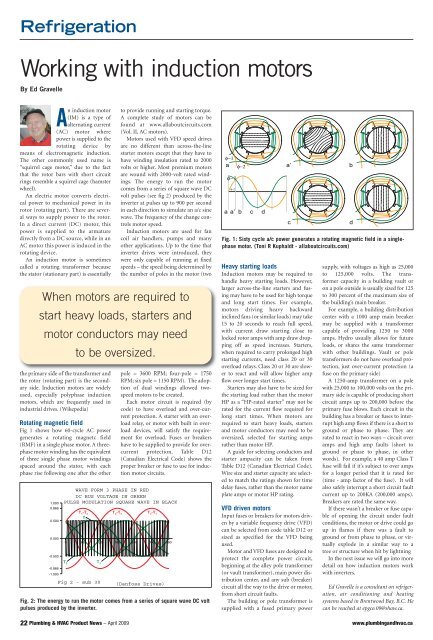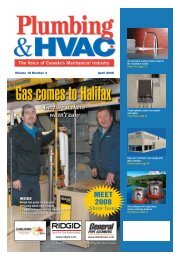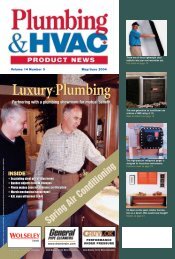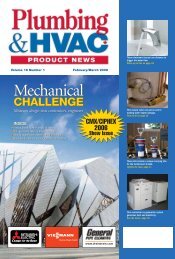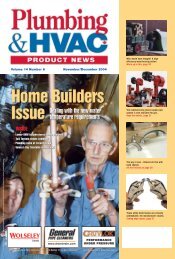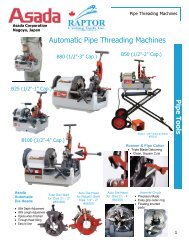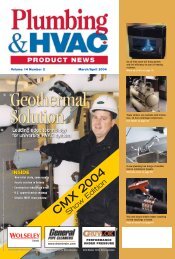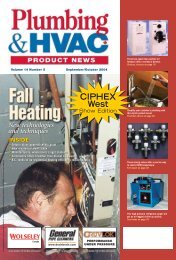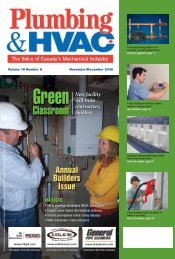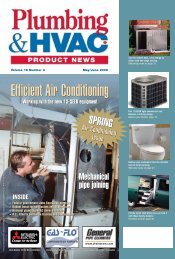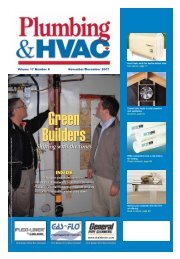phvac Dec 2006.qxd - Plumbing & HVAC
phvac Dec 2006.qxd - Plumbing & HVAC
phvac Dec 2006.qxd - Plumbing & HVAC
Create successful ePaper yourself
Turn your PDF publications into a flip-book with our unique Google optimized e-Paper software.
Refrigeration<br />
Working with induction motors<br />
By Ed Gravelle<br />
An induction motor<br />
(IM) is a type of<br />
alternating current<br />
(AC) motor where<br />
power is supplied to the<br />
rotating device by<br />
means of electromagnetic induction.<br />
The other commonly used name is<br />
“squirrel cage motor,” due to the fact<br />
that the rotor bars with short circuit<br />
rings resemble a squirrel cage (hamster<br />
wheel).<br />
An electric motor converts electrical<br />
power to mechanical power in its<br />
rotor (rotating part). There are several<br />
ways to supply power to the rotor.<br />
In a direct current (DC) motor, this<br />
power is supplied to the armature<br />
directly from a DC source, while in an<br />
AC motor this power is induced in the<br />
rotating device.<br />
An induction motor is sometimes<br />
called a rotating transformer because<br />
the stator (stationary part) is essentially<br />
the primary side of the transformer and<br />
the rotor (rotating part) is the secondary<br />
side. Induction motors are widely<br />
used, especially polyphase induction<br />
motors, which are frequently used in<br />
industrial drives. (Wikepedia)<br />
Rotating magnetic field<br />
Fig 1 shows how 60-cycle AC power<br />
generates a rotating magnetc field<br />
(RMF) in a single phase motor. A threephase<br />
motor winding has the equivalent<br />
of three single phase motor windings<br />
spaced around the stator, with each<br />
phase rise following one after the other<br />
to provide running and starting torque.<br />
A complete study of motors can be<br />
found at www.allaboutcircuits.com<br />
(Vol. II, AC motors).<br />
Motors used with VFD speed drives<br />
are no different than across-the-line<br />
starter motors except that they have to<br />
have winding insulation rated to 2000<br />
volts or higher. Most premium motors<br />
are wound with 2000-volt rated windings.<br />
The energy to run the motor<br />
comes from a series of square wave DC<br />
volt pulses (see fig 2) produced by the<br />
inverter at pulses up to 900 per second<br />
in each direction to simulate an a/c sine<br />
wave. The frequency of the change controls<br />
motor speed.<br />
Induction motors are used for fan<br />
coil air handlers, pumps and many<br />
other applications. Up to the time that<br />
inverter drives were introduced, they<br />
were only capable of running at fixed<br />
speeds – the speed being determined by<br />
the number of poles in the motor (two<br />
When motors are required to<br />
start heavy loads, starters and<br />
motor conductors may need<br />
to be oversized.<br />
<br />
<br />
<br />
<br />
<br />
<br />
<br />
pole = 3600 RPM; four-pole = 1750<br />
RPM; six pole = 1150 RPM). The adoption<br />
of dual windings allowed twospeed<br />
motors to be created.<br />
Each motor circuit is required (by<br />
code) to have overload and over-current<br />
protection. A starter with an overload<br />
relay, or motor with built in overload<br />
devices, will satisfy the requirement<br />
for overload. Fuses or breakers<br />
have to be supplied to provide for overcurrent<br />
protection. Table D12<br />
(Canadian Electrical Code) shows the<br />
proper breaker or fuse to use for induction<br />
motor circuits.<br />
WAVE FORM 3 PHASE IN RED<br />
DC BUS VOLTAGE IN GREEN<br />
PULSE MODULATION SQUARE WAVE IN BLACK<br />
<br />
<br />
<br />
<br />
<br />
<br />
<br />
<br />
<br />
<br />
Fig 2 - sub 30<br />
(Danfoss Drives)<br />
Fig. 2: The energy to run the motor comes from a series of square wave DC volt<br />
pulses produced by the inverter.<br />
φ−1<br />
a<br />
φ−1<br />
φ−2<br />
φ−2<br />
a a’ b c d<br />
Heavy starting loads<br />
Induction motors may be required to<br />
handle heavy starting loads. However,<br />
larger across-the-line starters and fusing<br />
may have to be used for high torque<br />
and long start times. For example,<br />
motors driving heavy backward<br />
inclined fans (or similar loads) may take<br />
15 to 20 seconds to reach full speed,<br />
with current draw starting close to<br />
locked rotor amps with amp draw dropping<br />
off as speed increases. Starters,<br />
when required to carry prolonged high<br />
starting currents, need class 20 or 30<br />
overload relays. Class 20 or 30 are slower<br />
to react and will allow higher amp<br />
flow over longer start times.<br />
Starters may also have to be sized for<br />
the starting load rather than the motor<br />
HP as a “HP-rated starter” may not be<br />
rated for the current flow required for<br />
long start times. When motors are<br />
required to start heavy loads, starters<br />
and motor conductors may need to be<br />
oversized, selected for starting amps<br />
rather than motor HP.<br />
A guide for selecting conductors and<br />
starter ampacity can be taken from<br />
Table D12 (Canadian Electrical Code).<br />
Wire size and starter capacity are selected<br />
to match the ratings shown for time<br />
delay fuses, rather than the motor name<br />
plate amps or motor HP rating.<br />
VFD driven motors<br />
Input fuses or breakers for motors driven<br />
by a variable frequency drive (VFD)<br />
can be selected from code table D12 or<br />
sized as specified for the VFD being<br />
used.<br />
Motor and VFD fuses are designed to<br />
protect the complete power circuit,<br />
beginning at the alley pole transformer<br />
(or vault transformer), main power distribution<br />
center, and any sub (breaker)<br />
circuit all the way to the drive or motor,<br />
from short circuit faults.<br />
The building or pole transformer is<br />
supplied with a fused primary power<br />
a’ b<br />
c<br />
Fig. 1: Sixty cycle a/c power generates a rotating magnetic field in a singlephase<br />
motor. (Toni R Kuphaldt - allaboutcircuits.com)<br />
d<br />
supply, with voltages as high as 25,000<br />
to 125,000 volts. The transformer<br />
capacity in a building vault or<br />
on a pole outside is usually sized for 125<br />
to 300 percent of the maximum size of<br />
the building’s main breaker.<br />
For example, a building distribution<br />
center with a 1000 amp main breaker<br />
may be supplied with a transformer<br />
capable of providing 1250 to 3000<br />
amps. Hydro usually allows for future<br />
loads, or shares the same transformer<br />
with other buildings. Vault or pole<br />
transformers do not have overload protection,<br />
just over-current protection (a<br />
fuse on the primary side)<br />
A 1250-amp transformer on a pole<br />
with 25,000 to 100,000 volts on the primary<br />
side is capable of producing short<br />
circuit amps up to 200,000 before the<br />
primary fuse blows. Each circuit in the<br />
building has a breaker or fuses to interrupt<br />
high amp flows if there is a short to<br />
ground or phase to phase. They are<br />
rated to react in two ways – circuit over<br />
amps and high amp faults (short to<br />
ground or phase to phase, in other<br />
words). For example, a 40 amp Class T<br />
fuse will fail if it’s subject to over amps<br />
for a longer period that it is rated for<br />
(time - amp factor of the fuse). It will<br />
also safely interrupt a short circuit fault<br />
current up to 200KA (200,000 amps).<br />
Breakers are rated the same way.<br />
If there wasn’t a breaker or fuse capable<br />
of opening the circuit under fault<br />
conditions, the motor or drive could go<br />
up in flames if there was a fault to<br />
ground or from phase to phase, or virtually<br />
explode in a similar way to a<br />
tree or structure when hit by lightning<br />
In the next issue we will go into more<br />
detail on how induction motors work<br />
with inverters.<br />
Ed Gravelle is a consultant on refrigeration,<br />
air conditioning and heating<br />
systems based in Brentwood Bay, B.C. He<br />
can be reached at epgco.09@shaw.ca.<br />
22 <strong>Plumbing</strong> & <strong>HVAC</strong> Product News – April 2009 www.plumbingandhvac.ca


